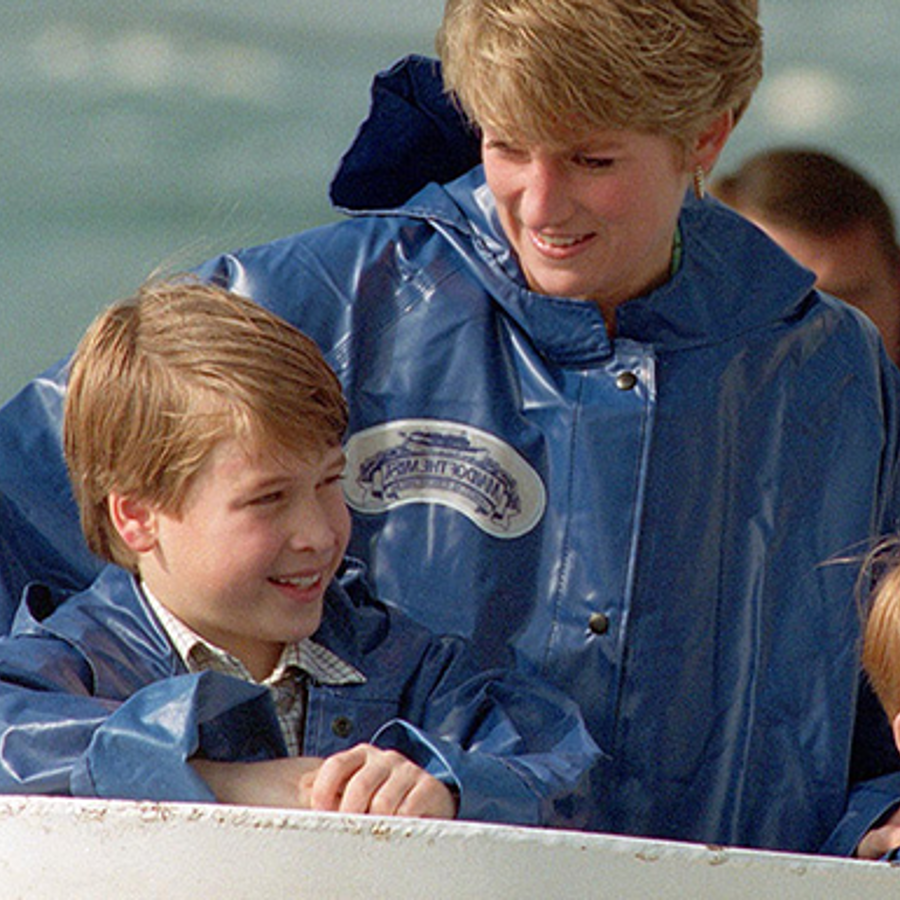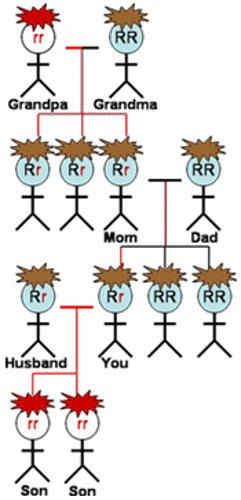
How can red hair skip a generation and reappear in a family?
December 19, 2007

- Related Topics:
- Red hair,
- Hair color,
- Pigmentation traits,
- Carrier,
- Dominant and recessive
A curious adult from Arkansas asks:
"I am a mother of two boys, 3 years and 8 months. My husband has dark brown hair and brown eyes and I have light brown hair and blue eyes and both our boys have red hair. We can trace red hair back two generations, but it skipped our parents and us. How does this happen?"
Traits like red hair or blue eyes that skip generations can be frustrating (especially if your mailman has red hair and/or blue eyes!). But it is perfectly natural. And explainable by genetics.
Many of our traits come from our genes. There are genes that determine eye shape, hair texture, hair, eye, and skin color, etc. The traits that are most likely to skip generations are the ones caused by recessive gene versions. To understand what this means, we need to remember two things about our genes.
First, we have two copies of most of our genes -- one from mom and one from dad. And second, our genes can come in different versions called alleles. These different versions can lead to different traits.

For example, there are versions of the MC1R gene that lead to red hair. And versions that don't lead to red hair.
What this all means is that people can have three possible combinations of the MC1R gene. They can have two non-red versions, two red versions, or one of each.
It is pretty obvious that having two non-red versions means you won't have red hair. And that having two red versions means you will have red hair. But what if you have one version of each?
This is where recessive comes in. Not all versions of genes are created equal -- some versions are "weaker" than other ones. In genetics speak, we'd say that some alleles are recessive and some are dominant. The red hair versions of the MC1R gene are recessive to the other MC1R versions.
So if you have a red and a non-red version of the MC1R gene, then you won't have red hair. But you carry the recessive red hair version that you can pass down to your kids. Another way to say this is that you are a carrier for red hair.
Carriers are the reason why traits can skip generations. I am going to use your story as a way of explaining why this is.
Writing and saying non-red version of MC1R or red version of MC1R gets a bit tiring after a while. So I will do what geneticists do. I will call the non-red version of the MC1R gene R and the red version r. I also used that naming system in this figure:

Imagine that your grandfather was a redhead and that your grandmother wasn't a carrier. This would make grandpa rr and grandma RR.
None of their kids would have red hair but they would all be carriers because grandpa would pass on his red hair gene. All the kids have a non-red copy of the MC1R gene (R) from grandma and a red copy (r) from grandpa -- they would all be Rr.
Let's say one of these kids is your mother and that your father wasn't a carrier. In other words, your mom is Rr and your dad is RR. Your mother has an equal chance of passing either the red (r) or the non-red (R) version to her kids.
Let's say she passed the red hair version to you. Since your dad wasn't a carrier, this means he passed only a non-red version (R) to you. So you are a carrier for red hair (Rr).
So now we have gone two generations without a redhead. Imagine that something similar happened on your husband's side of the family.
Now here you are, both carriers for red hair (Rr). As I said before, a carrier has an equal chance of passing either copy of a gene to his or her child. So each of your children has a 1 in 2 chance of getting a red hair version (r) from you and the same chance of getting a red hair version (r) from your husband.
To figure out the chances that you both will pass an r down to your kids, you multiply the chances together. This means that each child has a 1 in 4 chance of getting two r versions and having red hair. The chances for this happening with both your kids are 1 in 16 (again just multiplying the chances together).
To give you some idea about how likely this is, it is about the same chance as flipping a coin four times and getting four heads in a row. Or the same as a family having four boys in a row. Not the most common outcome but we've all seen families with kids of all one sex or the other.
So there you have it. Recessive traits like red hair can skip generations because they can hide out in a carrier behind a dominant trait. The recessive trait needs another carrier and a bit of luck to be seen. This means that it can sometimes take a few generations to finally make its presence known.

Author: Dr. D. Barry Starr
Barry served as The Tech Geneticist from 2002-2018. He founded Ask-a-Geneticist, answered thousands of questions submitted by people from all around the world, and oversaw and edited all articles published during his tenure. AAG is part of the Stanford at The Tech program, which brings Stanford scientists to The Tech to answer questions for this site, as well as to run science activities with visitors at The Tech Interactive in downtown San Jose.
 Skip Navigation
Skip Navigation
